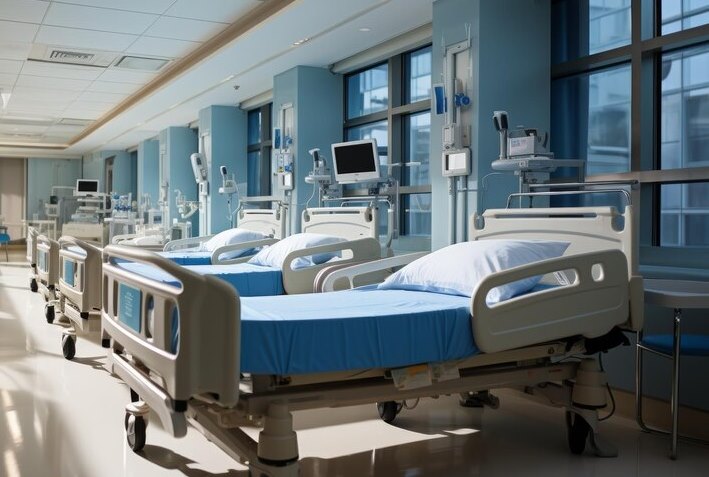
Hospital beds, often seen as simple pieces of furniture, play a crucial role in patient care, especially for those with cardiac conditions. The evolution of hospital beds, tailored to meet the needs of cardiac patients, highlights the intersection of medical science and engineering. These specialized beds are designed not only for comfort but also for enhancing recovery and supporting critical medical procedures. The evolution and importance of hospital beds for cardiac patients? This article delves into the significance, features, and advancements of hospital beds specifically designed for cardiac patients.
The Significance of Specialized Hospital Beds for Cardiac Patients
Cardiac patients require meticulous care due to the nature of their conditions. Heart diseases often necessitate constant monitoring, immediate medical interventions, and specialized support to ensure stability and recovery. Hospital beds designed for cardiac patients are equipped with features that address these needs, making them indispensable in modern healthcare settings.
Specialized cardiac beds provide the necessary support for patients with heart conditions, allowing for various positioning that can alleviate symptoms and prevent complications. For instance, these beds can be adjusted to ensure proper elevation, which is crucial for patients experiencing congestive heart failure or other conditions that cause fluid accumulation. Proper positioning can help reduce the workload on the heart and improve breathing, thereby enhancing patient comfort and outcomes.
Key Features of Cardiac Hospital Beds
-
Adjustable Positions: One of the primary features of cardiac hospital beds is their ability to be adjusted into multiple positions. This includes the Trendelenburg and reverse Trendelenburg positions, which are essential for managing blood pressure and improving circulation. The ability to elevate the head, legs, or both simultaneously can significantly impact a patient’s comfort and recovery.
-
Cardiac Chair Position: A unique feature of cardiac beds is the cardiac chair position. This allows the bed to transform into a chair-like configuration, enabling patients to sit up comfortably. This position is particularly beneficial for patients with heart conditions as it promotes better breathing and reduces the risk of pressure ulcers and deep vein thrombosis (DVT).
-
Integrated Monitoring Systems: Modern cardiac beds are often equipped with integrated monitoring systems. These systems can continuously monitor vital signs such as heart rate, blood pressure, and oxygen levels. The data collected can be directly fed into the hospital’s electronic medical record system, ensuring that healthcare providers have real-time access to critical information.
-
Emergency CPR Functions: In the event of a cardiac arrest, time is of the essence. Cardiac hospital beds are designed with emergency CPR functions that allow for rapid flattening of the bed and adjustment to optimal positions for resuscitation efforts. This feature can be life-saving, providing immediate support for emergency procedures.
-
Pressure Redistribution Mattresses: Cardiac patients often spend extended periods in bed, increasing the risk of pressure ulcers. Specialized mattresses in cardiac beds are designed to redistribute pressure and reduce the likelihood of skin breakdown. These mattresses can be adjusted to provide varying levels of firmness and support, tailored to the needs of each patient.
-
Patient Mobility Aids: Mobility is a crucial aspect of recovery for cardiac patients. Hospital beds designed for these patients often include features that assist with mobility, such as side rails that can be adjusted or removed, foot and hand supports, and built-in transfer aids. These features help patients move safely and encourage early mobilization, which is essential for preventing complications such as muscle atrophy and DVT.
Technological Advancements in Cardiac Hospital Beds
The integration of technology into hospital beds has revolutionized the care of cardiac patients. Advancements in medical technology have led to the development of smart beds that can communicate with other medical devices and healthcare systems. For instance, some beds are equipped with sensors that can detect changes in a patient’s position and automatically adjust to prevent bedsores.
Furthermore, the advent of telemedicine has seen the incorporation of video conferencing capabilities into hospital beds. This allows cardiac patients to have virtual consultations with their healthcare providers without the need to be transported to different areas of the hospital. This not only enhances patient comfort but also reduces the risk of infections and other complications associated with frequent movement.
Impact on Patient Outcomes
The specialized design and features of cardiac hospital beds have a profound impact on patient outcomes. By providing the necessary support and comfort, these beds play a critical role in the recovery process. Improved positioning and pressure relief can significantly reduce the incidence of complications such as bedsores, respiratory issues, and circulatory problems.
Moreover, the ability to monitor patients continuously and respond quickly to emergencies enhances the overall quality of care. Healthcare providers can make more informed decisions and intervene promptly when necessary, leading to better management of cardiac conditions and improved survival rates.
Future Directions
The future of cardiac hospital beds lies in further integration with digital health technologies. Innovations such as artificial intelligence (AI) and machine learning are expected to play a significant role in the development of next-generation hospital beds. AI can analyze data from monitoring systems to predict potential complications and suggest preemptive interventions.
Additionally, the trend towards personalized medicine will likely influence the design of hospital beds. Customizable features that cater to the specific needs of individual patients will become more prevalent, enhancing comfort and recovery.
Conclusion
At Penta Surgicals, hospital beds for cardiac patients are more than just furniture; they are essential tools in the management and treatment of heart conditions. The evolution of these beds, driven by advancements in technology and a deeper understanding of patient needs, has transformed cardiac care. By providing optimal support, enhancing monitoring, and facilitating emergency interventions, specialized cardiac hospital beds play a pivotal role in improving patient outcomes and advancing healthcare. As technology continues to evolve, these beds will undoubtedly become even more sophisticated, further enhancing their impact on patient care.





